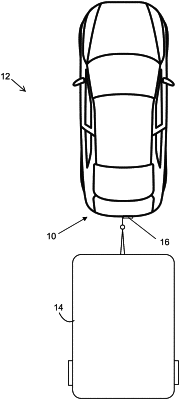| CPC H04N 23/54 (2023.01) [B62D 15/029 (2013.01); G06T 7/248 (2017.01); G06T 7/60 (2013.01); G06T 7/80 (2017.01); B60Q 9/008 (2013.01); G06T 2207/30252 (2013.01); G06V 20/56 (2022.01); G06V 2201/08 (2022.01)] | 27 Claims |

|
17. A vehicular trailering assist system, the vehicular trailering assist system comprising:
a camera disposed at a vehicle equipped with the vehicular trailering assist system, the camera viewing exterior and rearward of the vehicle;
wherein the camera comprises a CMOS imaging array having at least one million photosensor elements arranged in rows and columns;
an image processor operable to process image data captured by the camera;
wherein the vehicular trailering assist system is operable in a calibration mode when a trailer for which the vehicular trailering assist system is not calibrated is hitched to the vehicle;
wherein the trailer has a tongue that, with the trailer hitched to the vehicle, is hitched to the vehicle at a hitch ball at a rear portion of the vehicle;
wherein the trailer has a trailer beam length that is a longitudinal distance along the trailer between the tongue of the trailer and a center of an axle of the trailer;
wherein, with the vehicle towing the trailer hitched to the vehicle, and based at least on processing by the image processor of image data captured by the camera, the vehicular trailering assist system determines a trailer angle of the tongue of the trailer relative to the vehicle;
wherein, when the vehicular trailering assist system is operating in the calibration mode, and during a calibration drive with the vehicle towing the trailer hitched to the vehicle, the vehicle is driven straight in a forward direction until the vehicular trailering assist system, based at least on processing by the image processor of multiple frames of image data captured by the camera, determines that radial motion of the tongue of the trailer relative to the hitch ball at the rear portion of the vehicle is less than a first threshold radial motion;
wherein, during the calibration drive, and after determining that the radial motion is less than the first threshold radial motion, the vehicle is driven forward and turned until the vehicular trailering assist system determines, based at least on processing by the image processor of multiple frames of image data captured by the camera, that the determined radial motion of the tongue of the trailer relative to the hitch ball at the rear portion of the vehicle is less than a second threshold radial motion;
wherein the vehicular trailering assist system iteratively predicts a plurality of predicted trailer angles based on a corresponding plurality of potential trailer beam lengths ranging between an upper dimension above a baseline trailer beam length and a lower dimension below the baseline trailer beam length and selects a trailer angle from the plurality of predicted trailer angles that least deviates from a current trailer angle determined via processing by the image processor of image data captured by the camera;
wherein the potential trailer beam length that corresponds to the selected trailer angle that least deviates from the determined current trailer angle is used in determining trailer angles for that particular trailer during future non-calibration drives of the vehicle when towing that particular trailer with the vehicular trailering assist system not operating in the calibration mode;
wherein the potential trailer beam length that corresponds to the selected trailer angle that least deviates from the determined current trailer angle is stored in memory as the trailer beam length for that particular trailer; and
wherein, after the potential trailer beam length that corresponds to the selected trailer angle that least deviates from the determined current trailer angle is stored in memory as the trailer beam length for that particular trailer, and responsive to the vehicular trailering assist system recognizing that particular trailer when that particular trailer is subsequently hitched to the vehicle, the vehicular trailering assist system does not operate in the calibration mode and uses the potential trailer beam length stored in memory for that particular trailer in determining trailer angles for that particular trailer.
|